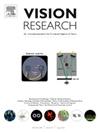A comparison of density-based and feature-based texture boundary segmentation
IF 1.4
4区 心理学
Q4 NEUROSCIENCES
引用次数: 0
Abstract
Previous studies have demonstrated that density of texture elements is an important perceptual aspect of textural appearance, and can enable texture segmentation in the absence of other cues. We compared segmentation thresholds for two kinds of second-order boundaries comprised of two species of micropatterns (e.g., horizontal and vertical Gabors): (1) Feature boundaries, with the same number of total micropatterns on opposite sides but different numbers of each micropattern species within each side, and (2) Density boundaries, with different numbers of total micropatterns on opposite sides, but with the same number of both micropattern species within each side. Contrary to the predictions of a standard late-pooling Filter-Rectify-Filter (FRF) model in which different micropattern specific first-order channels are analyzed by different second stage filters before pooling, we observed lower segmentation thresholds for density boundaries than feature boundaries. This suggests that density boundaries may be detected by a different, early-pooling mechanism. In a second experiment, we considered how two species of micropatterns combine for boundary segmentation. When two single-micropattern-species density boundaries are superimposed in-phase to form a new density boundary, the boundaries formed by each micropattern species combine via probability summation. By contrast, when two single-micropattern-species density boundaries are superimposed in opposite-phase to form a feature boundary, segmentation performance is worse than for either single-micropattern-species boundary alone. We conclude that the mechanisms for density-based texture segmentation are not identical to the mechanisms for feature-based segmentation and that density-sensitive mechanisms most likely integrate across multiple first-order filters responsive to different micropattern species.
基于密度和基于特征的纹理边界分割的比较
先前的研究表明,纹理元素的密度是纹理外观的一个重要感知方面,可以在没有其他线索的情况下实现纹理分割。我们比较了由两种微图案组成的两种二级边界(如水平Gabors和垂直Gabors)的分割阈值:(1)特征边界,相对侧微图案总数相同,但每侧微图案种数不同;(2)密度边界,相对侧微图案总数不同,但每侧微图案种数相同。与标准的延迟池化滤波-校正-滤波(FRF)模型的预测相反,我们观察到密度边界的分割阈值低于特征边界。在该模型中,不同的微模式特定的一阶通道在池化之前由不同的第二阶段滤波器分析。这表明密度边界可以通过不同的早期池化机制来检测。在第二个实验中,我们考虑了两种微模式如何结合在一起进行边界分割。当两个单一微图案-物种密度边界相叠加形成新的密度边界时,各微图案物种形成的密度边界通过概率求和组合在一起。相比之下,当两个单微图案-物种密度边界以相反的相位叠加形成特征边界时,分割性能比单独使用单个微图案-物种边界差。我们得出结论,基于密度的纹理分割的机制与基于特征的纹理分割的机制不同,密度敏感的机制很可能集成了多个一阶滤波器,响应不同的微图案种类。
本文章由计算机程序翻译,如有差异,请以英文原文为准。
求助全文
约1分钟内获得全文
求助全文
来源期刊

Vision Research
医学-神经科学
CiteScore
3.70
自引率
16.70%
发文量
111
审稿时长
66 days
期刊介绍:
Vision Research is a journal devoted to the functional aspects of human, vertebrate and invertebrate vision and publishes experimental and observational studies, reviews, and theoretical and computational analyses. Vision Research also publishes clinical studies relevant to normal visual function and basic research relevant to visual dysfunction or its clinical investigation. Functional aspects of vision is interpreted broadly, ranging from molecular and cellular function to perception and behavior. Detailed descriptions are encouraged but enough introductory background should be included for non-specialists. Theoretical and computational papers should give a sense of order to the facts or point to new verifiable observations. Papers dealing with questions in the history of vision science should stress the development of ideas in the field.
 求助内容:
求助内容: 应助结果提醒方式:
应助结果提醒方式:


